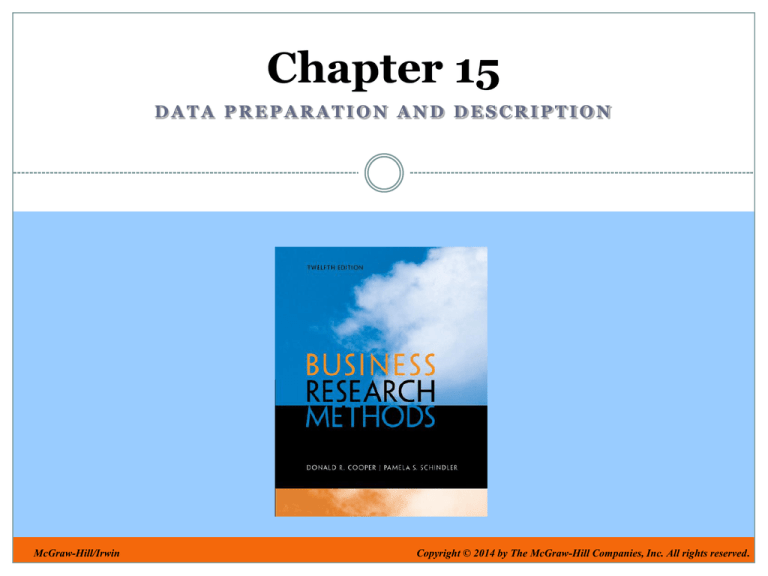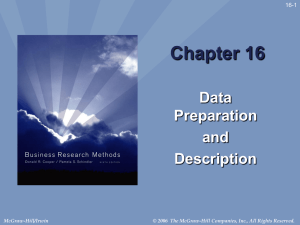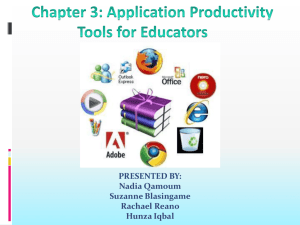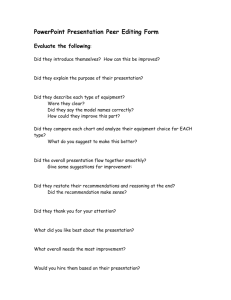
Chapter 15
DATA PREPARATION AND DESCRIPTION
McGraw-Hill/Irwin
Copyright © 2014 by The McGraw-Hill Companies, Inc. All rights reserved.
Learning Objectives
Understand . . .
The importance of editing the collected raw data
to detect errors and omissions.
How coding is used to assign number and other
symbols to answers and to categorize responses.
The use of content analysis to interpret and
summarize open questions.
15-2
Learning Objectives
Understand . . .
Problems with and solutions for “don’t know”
responses and handling missing data.
The options for data entry and manipulation.
15-3
Pull Quote
“Pattern thinking, where you look at what’s
working for someone else and apply it to your
own situation, is one of the best ways to make
big things happen for you and your team.”
David Novak, chairman and CEO,
Yum! Brands, Inc.
15-4
Data
Preparation
in the
Research
Process
15-5
Monitoring Online Survey Data
Online surveys need
special editing attention.
CfMC provides software
and support to research
suppliers to prevent
interruptions from
damaging data .
15-6
Editing
Accurate
Arranged for
simplification
Consistent
Criteria
Uniformly
entered
Complete
15-7
Field Editing
Field editing review
Entry gaps identified
Callbacks made
Results validated
15-8
Central Editing
Be familiar with instructions
given to interviewers and coders
Do not destroy the original entry
Make all editing entries identifiable and in
standardized form
Initial all answers changed or supplied
Place initials and date of editing
on each instrument completed
15-9
Sample
Codebook
15-10
Precoding
15-11
Coding Open-Ended Questions
6. What prompted you to purchase your
most recent life insurance policy?
_______________________________
_______________________________
_______________________________
_______________________________
_______________________________
_______________________________
_______________________________
_______________________________
15-12
Coding Rules
Appropriate to the
research problem
Exhaustive
Categories
should be
Mutually exclusive
Derived from one
classification principle
15-13
Content Analysis
15-14
Types of Content Analysis
Syntactical
Referential
Propositional
Thematic
15-15
Open-Question Coding
Locus of
Responsibility
Mentioned
A. Company
_____________
B. Customer
_____________
C. Joint CompanyCustomer
_____________
F. Other
_____________
Not
Mentioned
_______________
Locus of Responsibility
A. Management
_______________
1. Sales manager
2. Sales process
_______________
3. Other
4. No action area identified
_______________
B. Management
1. Training
C. Customer
1. Buying processes
2. Other
3. No action area identified
D. Environmental conditions
E. Technology
F. Other
Frequency
(n = 100)
10
20
7
3
15
12
8
5
20
15-16
Proximity Plot
15-17
Handling “Don’t Know” Responses
Question:
Years of
Purchasing
Do you have a productive relationship
with your present salesperson?
No
Don’t Know
10%
40%
38%
1 – 3 years
30
30
32
4 years or more
60
30
30
100%
n = 650
100%
n = 150
100%
n = 200
Less than 1 year
Total
Yes
15-18
Data Entry
Keyboarding
Digital/
Barcodes
Database
Programs
Optical
Recognition
Voice
recognition
15-19
Missing Data Solutions
Listwise Deletion
Pairwise Deletion
Replacement
15-20
Key Terms
• Bar code
Don’t know response
• Codebook
Editing
• Coding
Missing data
• Content analysis
Optical character
• Data entry
• Data field
• Data file
• Data preparation
• Data record
recognition
Optical mark recognition
Precoding
Spreadsheet
Voice recognition
• Database
15-21
Chapter 15
ADDITIONAL DISCUSSION OPPORTUNITIES
CloseUp: Dirty Data
Invalid: entry errors
Incomplete: missing, siloed, turf wars
Inconsistent: across databases
Incorrect: lost, falsified, outdated
Solutions: Data Steward, Data Protocols,
Error Detection Software
15-23
Snapshot: CBS labs
39 Million Visitors
Show Screenings
Dial Testing
Surveys
Focus Groups
15-24
PicProfile: Content Analysis
QSR’s XSight
software for
content analysis.
15-25
Snapshot: Netnography Data
Posted on Internet & intranets
Product & company reviews
Employee experiences
Message board posts
Discussion forum posts
15-26
Research Thought Leader
“The goal is to transform data into
information, and information into insight.
Carly Fiorina
former president and chairwoman,
Hewlett-Packard Co
15-27
PulsePoint: Research Revelation
55
The percent of white-collar workers
who answer work-related calls or email after work hours.
15-28
Chapter 15
DATA PREPARATION AND DESCRIPTION
Photo Attributions
Slide Source
6 Courtesy of CfMC Research Software
8 Courtesy of Western Watts
14 Courtesy of xSight
15 Eric Audras/Getty Images
19 Purestock/SuperStock
20 ©Pamela S. Schindler
24 ©fStop/SuperStock
25 Courtesy of QSR (xSight)
26 Scott Dunlap/Getty Images
15-30










